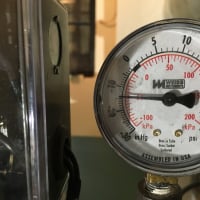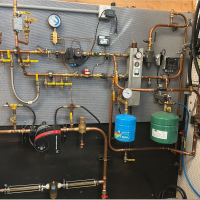How to set valve on expansion-tank loop
Hello, I have a hydronic system (radiant floor on 2 floors + a few radiators) with a gas boiler that you can see on the picture. The expansion tank and the air separator are on a very short loop that connect boiler in and out (visible on the picture). I don't know how to set the valve that's circled in red on the picture. When it's fully open it seems that the boiler keeps firing but no hot water circulates in the floors and radiators. I presume the small loop is "short-circuiting" the system in some way. When the circled valve is mostly-closed, the system seems to work but I'm afraid the expansion tank and air separator will not be able to work properly. I presume that closing it fully is a bad idea, but I'm a complete novice at this. Any advice?
Comments
-
How very odd. Is that one pump which i see the only pump for the system? Or are there also pumps on the lines which go off to radiator floor 1 and radiator floor 2 and at least one other line?
If there are it looks like a slightly misguided attempt at primary/secondary piping. If there aren't you are quite correct in that having it open all the way will short circuit the flow.
On the other hand, closing it will place the air separator out of the loop completely — so it might as well not be there — and the expansion tank in quite the wrong place for good (never mind best) practice.
So — if there are other pumps out there somewhere, I'd try closing it until I get decent return temperatures tot he boiler. If not, I'd close it far enough to get at least vaguely adequate flow out to the radiation…
Br. Jamie, osb
Building superintendent/caretaker, 7200 sq. ft. historic house museum with dependencies in New England0 -
Without more pictures and hopefully more circulators I don't see how this can work.
0 -
That at best is a attempt at something ,i've seen similar to in renovation ,add a level and flippers .You would be best advised to have that mess corrected for better operation .The top of the spirovent looks as though its been leaking for some time being the calcium build up . As improper as it looks if i was left to get working i would adjust the valve open enough to have some flow through it while maintaining flow through the zone valve i see, being i would image there's a circulator pump for the radiant zone and the other zone is using the circ on the boiler ? common things in lower grade work or just lack of knowledge . IF there is a seperate circulator for the radiant i would shut that zone off and turn the zone using the zone valve and then adjust the valve i think i would also check and see if heat is bypass through the mixing valve if so throttle back , Simply amazing i firmly believe the reason it works is due to the fact that i did not do it because if i did it would not work at all . It just goes to show how forgiving some system can be w improper piping . The catch is how well is it really working not only in comfort but in fuel usage .Also a lot of things just squeeze by until ya hit the single digits thats when the goin get tough.
peace and good luck clammy
R.A. Calmbacher L.L.C. HVAC
NJ Master HVAC Lic.
Mahwah, NJ
Specializing in steam and hydronic heating1 -
-
I can see what Clammy sees. I imagine something like this.
By closing off the valve circled in Red the boiler pump will send the water through the high temperature loop when that zone calls for heat. If that Red circled valve is open completely then there will be very little flow thru the high temperature loop/zone.
If the boiler pump also operates when there is a call for heat from the low temperature zone there is a chance of deadheading when the mixing valve closes off the hot water side in favor of the return water from the low temperature zone. This is why you can not close the Red circled valve completely. I am also guessing that the mixing valve visible in the photo on the lower low temperature loop is for cold water return boiler protection. But that is just a guess.
Can you post pictures of your low temperature loops, mixing valves and pumps that are not pictured, but illustrated above?
If this is close to your system, the best way to adjust that valve is to use an amperage reading on the boiler pump to see if there is not enough flow as you close the valve. You will need to do this under the most severe condition. That would be with the mixing valve temporarily adjusted to have the hot inlet side closed. Then close the hand valve until the amps on the pump reach about 80% of the rated amperage.
But for now Just close it completely and then open it one full turn and see if that gets the system to operate properly.
Edward Young Retired
After you make that expensive repair and you still have the same problem, What will you check next?
0 -
Thanks for the responses!
Here's a picture of the full system. The "high temp zone" indicated above is a heat exchanger for domestic hot water. Only one of the radiant floors has its own pump, and the other radiant floor zone has no pump and 5 radiators tacked on to it (controlled by the two zone valves you see on the picture below). The zone valves for the radiant floors are on the respective floors, so not visible on the picture.
It also looks like the black mixing valve is connected to a temp sensor placed on the pipe that sends hot water to radiant floor 1. So if that closes because temp is too hot, then possibly the only way water can circulate is through that small loop with the expansion tank. I'm hoping in that case the pump on the boiler stops, but I don't see how it would know. So I'm worried I might burn the pump if I close the valve on the small loop too much (at the moment I don't have the equipment to do the worst-case amperage measurement suggested above).
Another consideration could be that the boiler, being non-condensing, expects a high-enough return temp or there will be condensation and it will deteriorate. That small loop could be helping keep the boiler return temp high enough.
The system has not been working that great (radiators stop working depending on I don't know what; probably related to that valve I initially asked about being open too much) and it's guzzling propane like crazy.
0 -
Ok, so a strange bypass configuration.
What you want to do is set all your zones to call for heat, let the boiler heat up then adjust that valve so the boiler return water temp is around 140F when the boiler is supplying 160F water.
0 -
some pretty creative piping in this room
It looks like an attempt to do primary secondary but morphed into a parallel piping of sorts. To make it hydraulically correct would take a repipe
There needs to be a pump after mixing valves or they can just cross over. Little to no flow to the zone. Playing with that valve puts the circs in series and allows some flow I imagine.
Some fortunate and lucky set of circumstances allows this to work at all.
I suspect the boiler, it turns on and off a little, short cycles? That can really suck the LP
Bob "hot rod" Rohr
trainer for Caleffi NA
Living the hydronic dream0 -
looks to me like the valve has to be closed to make anything work. The valve separates the supply and return "headers". The expansion tank will still be connected to the system. Someone didn't have a clue or maybe 1/2 a clue. To work right it should have a pump added and be repiped primary secondary.
0 -
-
The main issue is it is not really a primary/ secondary piping. You only have P/S if you have closely spaced tees or a LLH or separator. There needs to be a hydraulic disconnect of some sort.
So in that pic, if the valve is closed the boiler pump is put in series with the radiant pump for example.
That 3 way valve has it's piping connections in a different orientation from typical 3 way thermostatic. And it looks to have a head on it like a TRV with the vented slots?
I see a cap tube on it as a remote sensor. I see a sensor strapped to the pipe above it. Can't see enough in the pics.
To get any flow to the zone valve circuits will require adjusting the valve. Problem is that adjustment would want to be different depending on how many ZVs are open.
Is there a pump on the indirect? If not it gets some unknown flow also depending on zone valves being open, also.
A textbook example of how forgiving hydronics can be.
Bob "hot rod" Rohr
trainer for Caleffi NA
Living the hydronic dream0 -
it is the most common piping error we see, over and over. It usually includes ghost flow issues also.
Good intentions, bad execution.
Bob "hot rod" Rohr
trainer for Caleffi NA
Living the hydronic dream0 -
Here's a picture of the thermostatic valve on the radiant-floor 1 loop. It is connected to the temp sensor on the pipe that sends water to radiant-floor 1. The only two pumps in the system are visible on the picture above. It sounds like repeated trial and error is going to be the best way forward for adjusting this system…
0 -
Come on now we all know its just pipes right ya hook em up turn it on and as long as nothing lets the smoke out and leaks then things are under control you pat yourself on the back give yourself a ata boy cash the check and move on to the next one.
I would hope who ever did this maybe learned some thing along the way and improved the way they pipe boilers in the future .But some how i doubt it they seemed to have mastered this trade completely and are now moving on to next trade to master its as easy as that . Time life book series
Another serious note i know if i did it that way it would not work period .
peace and good luck clammy
R.A. Calmbacher L.L.C. HVAC
NJ Master HVAC Lic.
Mahwah, NJ
Specializing in steam and hydronic heating0
Categories
- All Categories
- 87.3K THE MAIN WALL
- 3.2K A-C, Heat Pumps & Refrigeration
- 61 Biomass
- 428 Carbon Monoxide Awareness
- 120 Chimneys & Flues
- 2.1K Domestic Hot Water
- 5.8K Gas Heating
- 114 Geothermal
- 166 Indoor-Air Quality
- 3.7K Oil Heating
- 77 Pipe Deterioration
- 1K Plumbing
- 6.5K Radiant Heating
- 395 Solar
- 15.7K Strictly Steam
- 3.4K Thermostats and Controls
- 56 Water Quality
- 51 Industry Classes
- 50 Job Opportunities
- 18 Recall Announcements









